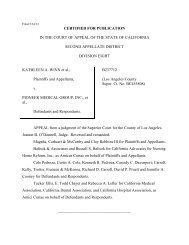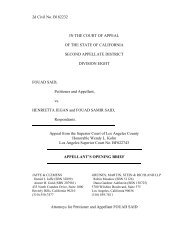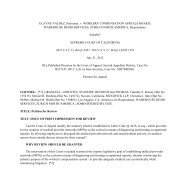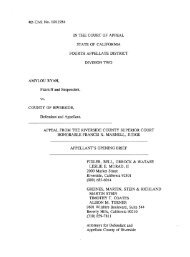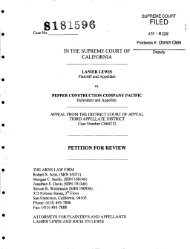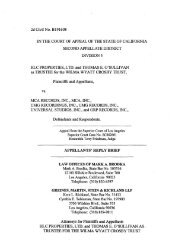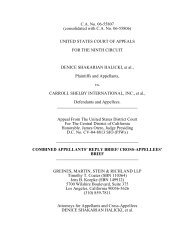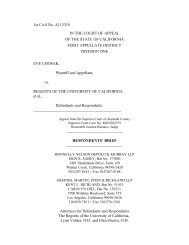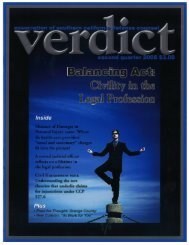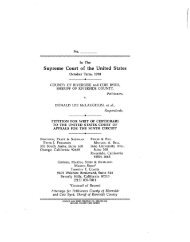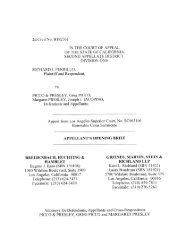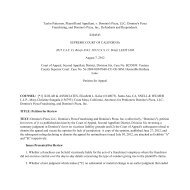Riverside County Sheriff's Dept. v. Stiglitz - Petition for Review
Riverside County Sheriff's Dept. v. Stiglitz - Petition for Review
Riverside County Sheriff's Dept. v. Stiglitz - Petition for Review
Create successful ePaper yourself
Turn your PDF publications into a flip-book with our unique Google optimized e-Paper software.
RIVERSIDE COUNTY SHERIFF'S DEPARTMENT, Plaintiff and Respondent vs. JAN<br />
STIGLITZ, Defendant. RIVERSIDE SHERIFF'S ASSOCIATION, Intervenor/Appellant.<br />
AND RELATED ACTIONS.<br />
S206350<br />
SUPREME COURT OF CALIFORNIA<br />
2012 CA S. Ct. Briefs 6350; 2012 CA S. Ct. Briefs LEXIS 1841<br />
November 1, 2012<br />
[<strong>Riverside</strong> Superior Court No. RIC10004998, after Published Decision of the Fourth<br />
District Court of Appeal, Div. Two, No. E052729].<br />
After Published Opinion of the Fourth Appellate District, Division Two, in the appeal<br />
from the Superior Court <strong>for</strong> the <strong>County</strong> of <strong>Riverside</strong>. Honorable Mac R. Fisher, Judge<br />
Presiding.<br />
<strong>Petition</strong> <strong>for</strong> Appeal<br />
COUNSEL: [*1] Bruce D. Praet, SBN 119430, Respondent, <strong>Riverside</strong> <strong>Sheriff's</strong> <strong>Dept</strong>., FERGUSON, PRAET &<br />
SHERMAN, Santa Ana, CA, Attorneys <strong>for</strong> Plaintiff/Respondent.<br />
TITLE: Respondent's <strong>Petition</strong> <strong>for</strong> <strong>Review</strong><br />
TEXT: TO: THE HONORABLE CHIEF JUSTICE AND ASSOCIATE JUSTICES OF THE SUPREME COURT OF<br />
THE STATE OF CALIFORNIA.<br />
Respondent, RIVERSIDE COUNTY SHERIFF'S DEPARTMENT (hereafter "The Department") respectively<br />
petitions this Court <strong>for</strong> review of the published decision and opinion filed by the Fourth District Court of Appeal,<br />
Division Two, on September 28, 2012, in <strong>Riverside</strong> <strong>County</strong> <strong>Sheriff's</strong> Department v. Jan <strong>Stiglitz</strong>, E052729. A copy of the<br />
slip opinion is attached as exhibit "1".<br />
INTRODUCTION AND QUESTION PRESENTED.<br />
As Presiding Justice McKinster stated during invited oral argument in the Fourth District Court of Appeal, "I think<br />
the Supreme Court would love to take this." The Fourth District Court of Appeal having now issued a published<br />
opinion in this matter in direct conflict with the First District Court of Appeal's published decision in Brown v.<br />
Valverde, (2010) 184 Cal.App. 4th 1531, Respondent respectfully agrees with Justice McKinster that it is now essential<br />
[*2] that the Supreme Court resolve the following issue:
2012 CA S. Ct. Briefs 6350; 2012 CA S. Ct. Briefs LEXIS 1841, *2<br />
Page 2<br />
Does a non-judicial hearing officer in a peace officer's administrative appeal of discipline have the<br />
statutory authority to hear a so-called Pitchess motion n1?<br />
n1 Referencing the exclusive process <strong>for</strong> accessing confidential peace officer personnel files first established in<br />
Pitchess v. Superior Court (1974) 11 Cal. 3d 531, subsequently codified in Evidence Code § 1043, et seq.<br />
STATEMENT OF THE CASE.<br />
Real Party in Interest, Kristy Drinkwater, was terminated from her position as a correctional deputy with the<br />
Department <strong>for</strong> falsifying her time records in order to obtain unearned compensation. By memorandum of<br />
understanding (MOU), Drinkwater was entitled to an administrative appeal of her termination be<strong>for</strong>e a mutually<br />
selected, neutral hearing officer (<strong>Stiglitz</strong>) pursuant to Government Code § 3304(b). Asserting that her termination was<br />
disproportionate to other employees who had falsified time records, [*3] Drinkwater filed a so-called Pitchess motion<br />
with the hearing officer seeking access to disciplinary files of unrelated deputies who might have been similarly<br />
charged.<br />
After the hearing officer granted the Pitchess motion, the Department challenged that ruling by way of a petition<br />
<strong>for</strong> writ of mandamus in the superior court pursuant to Code of Civil Procedure § 1094.5. During the pendency of the<br />
writ proceeding, the Second District Court of Appeal issued its decision in Brown v. Valverde, (2010) 183 Cal.App. 4th<br />
1531, declaring that Pitchess motions were statutorily limited to "court" proceedings and could not be heard by<br />
administrative hearing officers in DMV hearings.<br />
When the superior court granted the Department's writ petition and ordered the hearing officer to deny the Pitchess<br />
motion, Drinkwater (and the <strong>Riverside</strong> <strong>Sheriff's</strong> Association as Intervenor) filed their appeal. After briefing, the Court<br />
of Appeal invited oral argument and entertained an extraordinary hour long debate of the novel issues presented by this<br />
case.<br />
NECESSITY FOR REVIEW<br />
1. The Published Opinion Of The Fourth District Court Of Appeal is in Direct Conflict [*4] With The<br />
Published Decision of the First Appellate District in Brown v. Valverde (2010) 183 Cal.App. 4th 1531.<br />
Noting that the statutory scheme governing DMV administrative per se hearings was conspicuously void of any<br />
authority <strong>for</strong> non-judicial hearing officers to consider Pitchess motions, the Brown court recently and correctly held that<br />
such a statutorily controlled discovery process seeking access to confidential peace officer personnel files is not<br />
available in such administrative hearings. 183 Cal.App.4th at 1547-1549.<br />
Yet, after acknowledging that the Brown court had correctly ruled that the absence of statutory authority precluded<br />
Pitchess motions in DMV administrative per se hearings, the court in the instant case has attempted to distinguish<br />
Brown by completely rewriting Government Code § 3304(b) to add non-existent language to somehow authorize<br />
Pitchess discovery in peace officer administrative appeals under the blanket guise of "due process". n2 [Slip Op.,<br />
p.21-22] Glossing completely over the threshold absence of statutory authority <strong>for</strong> Pitchess discovery in peace officer<br />
administrative disciplinary [*5] hearings, the instant court instead jumps into a lengthy discussion regarding the<br />
relevancy of disparate discipline in peace officer appeals.<br />
n2 Like the statutory scheme governing DMV administrative per se hearings, Government Code § 3304(b) is
2012 CA S. Ct. Briefs 6350; 2012 CA S. Ct. Briefs LEXIS 1841, *5<br />
Page 3<br />
completely void of any language authorizing Pitchess discovery.<br />
Quite frankly, the Department does not disagree with the relevancy of a disparate discipline defense in any<br />
administrative appeal. However, the existence of such a defense does not and cannot override the statutory privileges<br />
attached to peace officer personnel files. Penal Code § 832.5 et seq. Regardless of the validity of any defense, due<br />
process simply does not create its own discovery process capable of superseding the very specific Pitchess discovery<br />
process which is expressly regulated by statute. Evidence Code § 1043, et. seq. It has long been established that no other<br />
discovery process can take precedence over the statutory scheme controlling the discovery of confidential [*6] peace<br />
officer personnel files. People v. Superior Court (Gremminger) (1997) 58 Cal.App.4th 397, 403.<br />
Un<strong>for</strong>tunately, the instant opinion has now created a direct conflict between the published decisions of two District<br />
Courts of Appeal. Thus, if the Brown court is correct, the long standing practice of limiting Pitchess motions to the<br />
exclusive jurisdiction of the courts will remain intact and consistent with the statutory language expressly governing<br />
such discovery. However, the latest decision of the Fourth District Court of Appeal has attempted to rewrite governing<br />
statutes so as to suddenly expand Pitchess discovery to non-judicial hearing officers in peace officer administrative<br />
appeals with innumerable collateral consequences. In either case, the conflict between these two published decisions<br />
demonstrates the need <strong>for</strong> Supreme Court review in order to establish uni<strong>for</strong>mity of decisions.<br />
2. The Statutory Scheme Encompassing the Pitchess Process Contains an Unresolved Ambiguity.<br />
As the lower court observed, the dilemma facing the District Courts of Appeal is the glaring fact that "there is an<br />
ambiguity" in the statutory scheme governing [*7] the exclusive Pitchess process controlling access to confidential<br />
peace officer personnel files. [Slip Op., p. 28].<br />
With the exception of a single reference to "administrative body" in Evidence Code § 1043(a), the entire statutory<br />
Pitchess process refers exclusively to how "the court" will handle such motions:<br />
. Evidence Code § 1045(b) - "the court shall examine the in<strong>for</strong>mation in chambers in con<strong>for</strong>mity with<br />
section 915."<br />
. Evidence Code § 1045(c) - "the court shall determine relevance."<br />
. Evidence Code § 1045(d) - "the court may issue protective orders."<br />
. Evidence Code § 1045(e) - "the court may limit disclosure."<br />
. Evidence Code § 915 - refers exclusively to "the court" and "the judge" conducting in camera<br />
inspections.<br />
Yet, in contrast to the well-reasoned approach of the Brown court and, in order to reach the strained conclusion that<br />
a non-judicial hearing officer is somehow authorized to hear Pitchess motions, the instant court has now rendered a<br />
statutory interpretation of the entire Pitchess process so as to exclude five clear mandates that such [*8] motions be<br />
determined exclusively by "the court." Conversely, this Court has long held that a single reference to one subject (e.g.<br />
"administrative body") cannot be considered in isolation, but instead must be harmonized within the statutory<br />
framework as a whole. People v. Drake (1977) 19 Cal.3d 749, 755. In fact, the omission of a reference from similar<br />
statutes concerning a related subject is significant to show that a different intention existed. Ibid.<br />
Ironically, Justices King and Richli agreed during oral argument on a system which would have seemingly<br />
harmonized the conflicting language by simply allowing an administrative hearing officer to make the preliminary<br />
determination of good cause and relevancy of a Pitchess motion in these settings, but only permitting the court to
2012 CA S. Ct. Briefs 6350; 2012 CA S. Ct. Briefs LEXIS 1841, *8<br />
Page 4<br />
review the actual records in camera and issue appropriate orders regarding their disclosure. In addition to reconciling<br />
the ambiguity in the statutes, this would have had the added benefit of insulating the non-judicial hearing officer from<br />
exposure to prejudicial in<strong>for</strong>mation as well as protecting the privacy rights of uninvolved officers. Un<strong>for</strong>tunately, this<br />
[*9] reasonable interpretation was apparently ignored in the final written decision.<br />
As both appellate courts noted, a review of the legislative history of the Pitchess statutes as a whole sheds<br />
"absolutely no additional light" on the Legislature's intention with regard to the single reference to the phrase<br />
"administrative body". When such is the case, it is appropriate to examine extrinsic sources to achieve the overall<br />
purpose of statutory scheme to avoid construction that would lead to absurd consequences. Smith v. Superior Court<br />
(2006) 39 Cal.4th 77, 83.<br />
Perhaps because no court has previously extended the Pitchess discovery process to administrative hearings, this<br />
appellate decision will now <strong>for</strong> the first time ever open the proverbial flood gates in a <strong>for</strong>um ill-equipped to deal with<br />
legislatively mandated judicial determinations. As the Brown court aptly noted, many of these administrative hearing<br />
officers are not even lawyers who are powerless to determine the sensitive privilege issues attached to peace officer<br />
personnel files. Brown, p. 1552. In fact, suddenly entrusting them with such judicial tasks would render no less than five<br />
statutory [*10] references to "the court" meaningless and usurp the Legislature's clear mandate that Pitchess<br />
determinations shall be limited to qualified judicial officers capable of balancing the sensitive privacy issues involved<br />
and empowered to en<strong>for</strong>ce related orders.<br />
3. The Issue Presented Has Widespread Statewide Application.<br />
As evidenced by the many occasions this Court has had to decide both Pitchess and Peace Officer Bill of Rights<br />
(POBR) issues, there are literally hundreds, if not thousands, of administrative appeals of peace officer discipline<br />
throughout the state each year. Although these hearings have presumably proceeded <strong>for</strong> years without non-judicial<br />
officers considering Pitchess motions, this latest appellate decision will create widespread confusion with little or no<br />
clear guidelines to apply this unprecedented expansion of an otherwise unbroken process.<br />
The statutory scheme now commonly referenced as the Pitchess process was enacted in 1978 to balance the rights<br />
of criminal defendants against the privacy rights of the involved peace officers. City of Santa Cruz v. Municipal Court<br />
(1989) 49 Cal.3d 74, 81. In order to minimize so-called [*11] "fishing expeditions", the Legislature later rein<strong>for</strong>ced the<br />
narrow scope of Pitchess discovery to only "involved officers" by subsequently adding Evidence Code § 1047.<br />
Yet, this latest extraordinary expansion of the Pitchess process to administrative appeals of peace officer discipline<br />
will now entrust the sensitive privacy of completely uninvolved officers to non-judicial hearing officers. For example, a<br />
peace officer who accepted discipline and thereafter hopes to move <strong>for</strong>ward with his/her career will now <strong>for</strong>ever have<br />
the potential of prior discipline resurfacing because some completely uninvolved officer can now file a Pitchess motion<br />
in their own unrelated administrative appeal. Even worse, the privacy rights of the previously disciplined officer will<br />
now be analyzed by a non-judicial officer, with virtually zero power to protect the files, in some sort of undefined<br />
process if this appellate decision is allowed to stand. This Court has already emphasized that the examination of<br />
sensitive peace officer personnel files should only occur in camera in accordance with the requirements of Evidence<br />
Code § 915 (i.e. by "the court"). People v. Mooc (2001) 26 Cal.4th 1216, 1229. [*12]<br />
The fact that the Pitchess discovery process has never be<strong>for</strong>e been expanded to non-judicial administrative hearings<br />
in over 30 years is strong evidence that the Brown court got it right and the instant opinion is misplaced. On the other<br />
hand, the recent conflict between the District Courts of Appeal now leaves over 500 law en<strong>for</strong>cement agencies in the<br />
state of Cali<strong>for</strong>nia with a mixed and untenable dilemma which only this Court can resolve. Moreover, as new peace<br />
officer disciplinary cases arise every day, the urgency of clear guidance from this learned Court becomes imperative.<br />
4. Conclusion.<br />
As Presiding Justice McKinster observed during oral argument, "I presume that the Supreme Court should have
2012 CA S. Ct. Briefs 6350; 2012 CA S. Ct. Briefs LEXIS 1841, *12<br />
Page 5<br />
an interest in this." It is evident that the Court of Appeal has recognized the dilemma created by the statutory<br />
ambiguity within the Pitchess process and the conflict it has created by ruling contrary to the Brown court. Under the<br />
a<strong>for</strong>ementioned circumstances, Respondent respectfully urges the Court to consider this issue of statewide importance<br />
by granting this <strong>Petition</strong> <strong>for</strong> <strong>Review</strong>.<br />
Dated: October 30, 2012<br />
Respectfully submitted,<br />
FERGUSON, [*13] PRAET & SHERMAN<br />
A Professional Corporation<br />
By: /s/ [Signature]<br />
Bruce D. Praet, Attorneys <strong>for</strong><br />
Respondent, <strong>Riverside</strong> <strong>Sheriff's</strong> <strong>Dept</strong>.<br />
STATEMENT OF RELATED CASES<br />
To the knowledge of Respondent <strong>Riverside</strong> <strong>Sheriff's</strong> Department, there are no related cases pending in this Court.<br />
Dated: October 30, 2012<br />
Respectfully submitted,<br />
FERGUSON, PRAET & SHERMAN<br />
A Professional Corporation<br />
By: /s/ [Signature]<br />
Bruce D. Praet, Attorneys <strong>for</strong><br />
Respondent, <strong>Riverside</strong> <strong>Sheriff's</strong> <strong>Dept</strong>.<br />
CERTIFICATE OF WORD COUNT COMPLIANCE<br />
1. This brief complies with the type volume limitation of Cali<strong>for</strong>nia Rules of Court, Rule 8.204 in that<br />
this brief contains 1,975 words.<br />
2. This brief complies with the typeface requirements of Cali<strong>for</strong>nia Rules of Court, Rule 8.204 and type<br />
style requirements as this brief has been prepared in proportionally spaced typeface using Word Perfect<br />
X3, Times New Roman 13 point font.<br />
Dated: October 30, 2012<br />
Respectfully submitted,<br />
FERGUSON, PRAET & SHERMAN<br />
A Professional Corporation<br />
By: /s/ [Signature]<br />
Bruce D. Praet, Attorneys <strong>for</strong><br />
Respondent, <strong>Riverside</strong> <strong>Sheriff's</strong> <strong>Dept</strong>.<br />
PROOF OF SERVICE
2012 CA S. Ct. Briefs 6350; 2012 CA S. Ct. Briefs LEXIS 1841, *13<br />
Page 6<br />
STATE [*14] OF CALIFORNIA, COUNTY OF ORANGE<br />
I, Cathy Sherman, employed in the a<strong>for</strong>esaid <strong>County</strong>, State of Cali<strong>for</strong>nia; I am over the age of 18 years and not a<br />
party to the within action. My business address is 1631 East 18th Street, Santa Ana, Cali<strong>for</strong>nia 92705-7101.<br />
On October 30, 2012, served the RESPONDENT'S PETITION FOR REVIEW on the interested parties in this<br />
action by placing a true copy thereof, enclosed in a sealed envelope, addressed as follows:<br />
SEE ATTACHED SERVICE LIST<br />
XXX (By Mail) I placed such envelope with postage thereon fully paid to be placed in the United States<br />
mail at Santa Ana, Cali<strong>for</strong>nia.<br />
XXX (State) I declare under penalty of perjury under the laws of the State of Cali<strong>for</strong>nia that the<br />
<strong>for</strong>egoing is true and correct.<br />
Executed on October 30, 2012, at Santa Ana, Cali<strong>for</strong>nia.<br />
/s/ [Signature]<br />
Cathy Sherman<br />
SERVICE LIST<br />
Dennis J. Hayes, Esq.<br />
Adam Chaikin, Esq.<br />
Hayes & Cunningham<br />
3258 Fourth Avenue<br />
San Diego, CA 92103<br />
Jan <strong>Stiglitz</strong>, Arbitrator<br />
Cali<strong>for</strong>nia Western School of Law<br />
225 Cedar Street<br />
San Diego, CA 92101<br />
Clerk of the Court<br />
Cali<strong>for</strong>nia Court of Appeal<br />
Fourth District, Division Two<br />
No. E052729 [*15]<br />
3389 Twelfth Street<br />
<strong>Riverside</strong>, CA 92501<br />
Michael P. Stone, Esq.<br />
Muna Busailah, Esq.<br />
Travis M. Poteat, Esq.<br />
Stone Busailah LLP.<br />
200 E. Del Mar Blvd., Suite 350<br />
Pasadena, CA 91105<br />
Clerk of the Court<br />
<strong>Riverside</strong> Superior Court
2012 CA S. Ct. Briefs 6350; 2012 CA S. Ct. Briefs LEXIS 1841, *15<br />
Page 7<br />
4050 Main Street<br />
<strong>Riverside</strong>, CA 92501<br />
Office of the Attorney General<br />
1300 "I" Street<br />
Sacramento, CA 95814-2919<br />
[SEE EXHIBIT "1" IN ORIGINAL]



